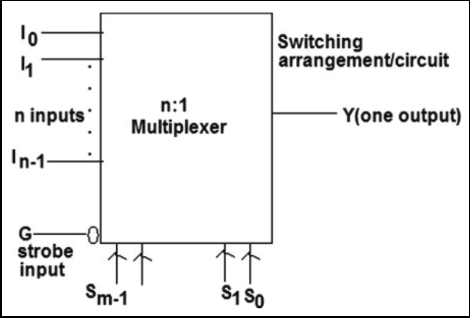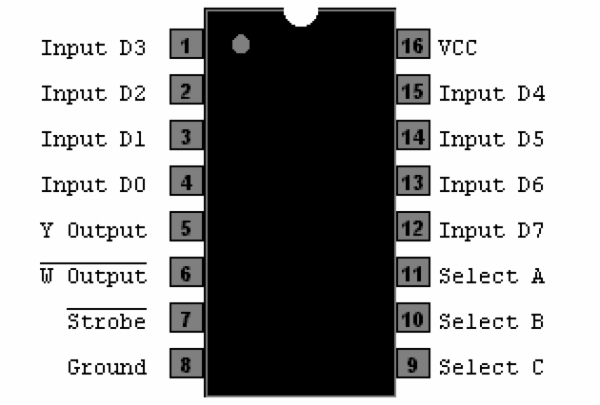Multiplexer (or Data selector)
Multiplexer or a data selector contains the following:
- n number of inputs of the multiplexer
- only one output of the multiplexer
- m select/Address lines
- one strobe/enable input (optional)

All inputs and outputs should be purely logical or binary input.
For n : 1 multiplexer, each input will be selected at the single output at any instant of time, depends upon the input applied to the select/address inputs. Switching circuit connects a particular input to the output
Here m and n are related by
So for a 4 : 1 multiplexer, the number of inputs is 4 and m = 2 ()

A、B、C 三个pin(管脚)是3个2进制数(0 or 1),被用来表示中的10进制 number
之所以说 是input, 是因为当你的 A、B、C 三个pin(管脚)输入的2进制刚好表示 中的 10进制时,OUTPUT Y会输出对应的 的高低电平,比如:
A、B、C都给0,D0给1,那么Y就输出1
这样就实现了数据选择器顾名思义的功能: 通过A、B、C三个输入,控制Y端口输出对应的D0~D7的输入值
Let us consider, a 4 : 1 multiplexer having 4 inputs, 2 select lines, one output, one strobe inputs. Strobe inputs should be grounded for enabling the multiplexer and can perform its intended function.
默认情况下,英文书上写的,如果你让 Strobe pin 输入0,mutiplexer正常工作;输入1,停止工作
但根据国情和大学的教学水平以及英语翻译能力,国内的教科书可能不一样
Commercial multiplexers will be
2 : 1, 4 : 1, 8 : 1, 16 : 1, ...
m = 1, m = 2, m = 3, m = 4
这里是讲的是,商用的mutiplexer有以上种类
国内数子电子课程为了节省电子元件,可能会让你用 multiplexer 做三人表决电路的实验,原理很简单,原来的输入变成A、B、C,原来应该返回1或0的地方用把D连起来方法批量的输入1或0